
РЕЗОЛЮЦІЯ: Громадського обговорення навчальної програми статевого виховання
ЧОМУ ФОНД ОЛЕНИ ПІНЧУК І МОЗ УКРАЇНИ ПРОПАГУЮТЬ "СЕКСУАЛЬНІ УРОКИ"
ЕКЗИСТЕНЦІЙНО-ПСИХОЛОГІЧНІ ОСНОВИ ПОРУШЕННЯ СТАТЕВОЇ ІДЕНТИЧНОСТІ ПІДЛІТКІВ
Батьківський, громадянський рух в Україні закликає МОН зупинити тотальну сексуалізацію дітей і підлітків
Відкрите звернення Міністру освіти й науки України - Гриневич Лілії Михайлівні
Представництво українського жіноцтва в ООН: низький рівень культури спілкування в соціальних мережах
Гендерна антидискримінаційна експертиза може зробити нас моральними рабами
ЛІВИЙ МАРКСИЗМ У НОВИХ ПІДРУЧНИКАХ ДЛЯ ШКОЛЯРІВ
ВІДКРИТА ЗАЯВА на підтримку позиції Ганни Турчинової та права кожної людини на свободу думки, світогляду та вираження поглядів
- Гідрологія і Гідрометрія
- Господарське право
- Економіка будівництва
- Економіка природокористування
- Економічна теорія
- Земельне право
- Історія України
- Кримінально виконавче право
- Медична радіологія
- Методи аналізу
- Міжнародне приватне право
- Міжнародний маркетинг
- Основи екології
- Предмет Політологія
- Соціальне страхування
- Технічні засоби організації дорожнього руху
- Товарознавство продовольчих товарів
Тлумачний словник
Авто
Автоматизація
Архітектура
Астрономія
Аудит
Біологія
Будівництво
Бухгалтерія
Винахідництво
Виробництво
Військова справа
Генетика
Географія
Геологія
Господарство
Держава
Дім
Екологія
Економетрика
Економіка
Електроніка
Журналістика та ЗМІ
Зв'язок
Іноземні мови
Інформатика
Історія
Комп'ютери
Креслення
Кулінарія
Культура
Лексикологія
Література
Логіка
Маркетинг
Математика
Машинобудування
Медицина
Менеджмент
Метали і Зварювання
Механіка
Мистецтво
Музика
Населення
Освіта
Охорона безпеки життя
Охорона Праці
Педагогіка
Політика
Право
Програмування
Промисловість
Психологія
Радіо
Регилия
Соціологія
Спорт
Стандартизація
Технології
Торгівля
Туризм
Фізика
Фізіологія
Філософія
Фінанси
Хімія
Юриспунденкция
Human gene therapy
Gene therapy is the treatment of human diseases. It involves 3 steps: 1) the removal of some of the patient's cells; 2) the introduction of normal, functional copies of genes that are defective in the patient into these cells; and, 3) the rein- troduction of transgenic repaired cells into the patient.
 |
Industrial applications
By using DNA technologies some cleaning products, such as detergents, are produced.
Agricultural applications
Recombinant DNA technology is being used to improve crops in a number of ways, by increasing their productivity and by making them more nutritious and cold resistant. Recombinant DNA technology promises many practical benefits in the field of agriculture. Some milk cows are being injected with bovine growth hormone (BGH) produced by genetically modified E. coli in order to increase milk production. In plants, some herbicide-resistant plants have been produced.
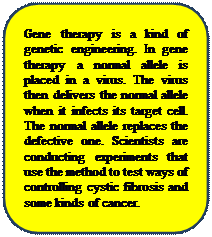 | 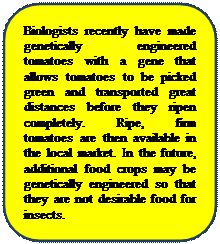 | ||

Forensics applications
DNA fingerprints obtained from several samples of tissue found at the scenes of violent crimes provide evidence in trials. It is also useful in paternity disputes.
Environmental or ecological applications
Genetic engineering can be used to modify the metabolism of microorganisms so that they can be used to extract minerals from the environment or degrade waste. For example, many bacteria can extract heavy metals, such as copper, lead, and nickel from their environment and incorporate the metals into compounds such as copper sulfate or lead sulfate which are readily recoverable
Human Genome Project
Completed in 2003, the Human Genome Project (HGP) was a 13-year project coordinated by the 0. S. Department of Energy and the National Institutes of Health. The Wellcome Trust (U. K.) became a major partner; additional contributions came from Japan, France, Germany, China, and others.

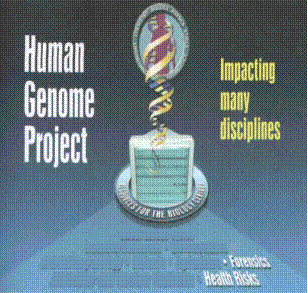
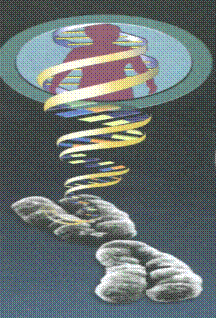
Project goals were to:
1. Identify all the approximately 20.000-25.000 genes in human DNA
2. Determine the sequences of the 3 billion chemical base pairs thatmake up human DNA,
3. Store this information in databases,
4. Improve tools for data analysis,
5. Transfer related technologies to the private sector, and
6. Address the ethical, legal, and social issues (ELSI) that may arisefromthe project.
Though the HGP is finished, analysis of the data will continue for many years. An important feature of the HGP project was the federal government's long-standing dedication to the transfer of technology to the private sector. By licensing technologies to private companies and awarding grants for innovative research, the project catalyzed the multibillion-dollar CJ. S. biotechnology industry and fostered the development of new medical applications.







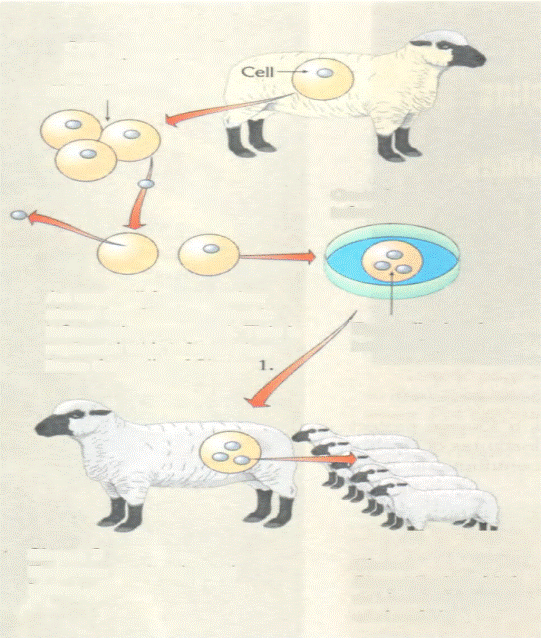
Cloning
Cloning is a biological technique which is used to produce offspring with desired traits. A clone is an organism that has exactly the same genes as the organism from which it was produced. It is something like a genetic copy of an organism.
Nowadays biologists are cloning some plants animals. In plants, cloning is not very difficult, just cut a stem from one plant, and put the stem in soil. Water it, soon you will have a whole new plant which is genetically identical to the plant from which the stem was cut. Cloning is more complex in animals. In spite of that, biologists have cloned some animals, such as sheep and pigs.
Biologists take the nucleus of an animal's body cell and insert that nucleus into another animal's body cell to produce a new individual, as in the figure. Dolly became the first cloned mammal in 1996. She was the result of the cloning of a somatic cell taken from one of the mammary glands of an adult female sheep.
Cloning humans using this technology is not a strong possibility due to laws in place against experimenting on humans. Cloning humans has been pronounced illegal in Britain. Ian Wilmut, an embryologist and leader of the team at Roslin Institute, USA, has denied that attempts have been madeclone humans.
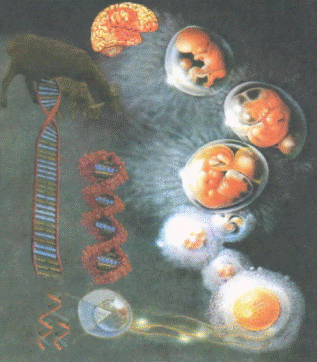
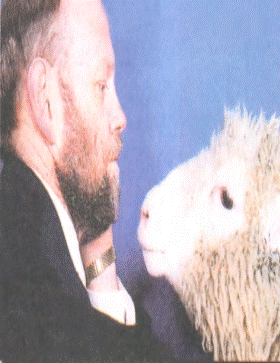
LABORATORY
Microscope
With the naked eye, we can't distinguish objects smaller than 0.0001 m (0.1 mm) in size. In laboratories, special tools are used to magnify such very small objects. Those tools are microscopes. Simply, microscopes allow observation of very small objects.
Today, many different types of microscopes, such as the phase contrast microscope, fluorescence microscope, and electron microscope, are used to better study small objects. However, the most commonly used microscopes are compound (light) microscopes, as shown on the left.
First of all, it must be known that the microscopeis a delicate instrument and requires proper care. That's why the following guidelines should be observed.

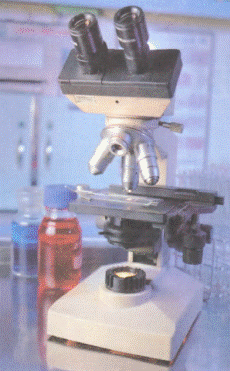
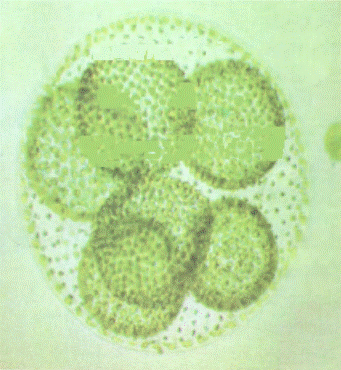
Using the microscope
1. Hold the microscope with both hands and set it down carefully.
2. Switch on the lamp (if there is one), or turn the mirror towards the light source.
3. Rotate the low power objective into place.
4. Some materials are best viewed in dim light, others in bright light. The light intensity can be regulated by using the diaphragm.
5. Put the material to be examined on the stage under the lens
(objective).
6. Look through the eye piece.
7. By using the coarse adjustment, try to focus the image.
8. With the fine adjustment, sharpen the image.
9. Use more powerful lenses if needed.
Читайте також:
- A Short Course in Human Relations
- B. Express your personal point of view regarding the challenges that are in store for us in terms of preserving the environment and saving the humankind in the near future.
- Human Factor and Aviation Safety Problems
- Humanities
- Humans vs. the environment - A thought experiment
- Lection 11. Role of Melatonin in the Regulation of Human Circadian Rhythms and Sleep
- Miniature human liver developed from stem cells
- MULTIFUNCTIONAL DEVICE FOR REFLEXOTHERAPY
- SPACE AND HUMAN SURVIVAL
- Space and Human Survival, Part I
- Space and Human Survival, Part II
| <== попередня сторінка | | | наступна сторінка ==> |
| Medical and pharmaceutical applications | | | Magnification |
|
Не знайшли потрібну інформацію? Скористайтесь пошуком google: |
© studopedia.com.ua При використанні або копіюванні матеріалів пряме посилання на сайт обов'язкове. |